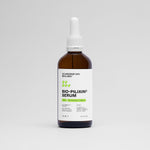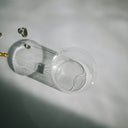Hair loss affects millions of people worldwide, and minoxidil has become one of the most popular treatments available. Originally developed as a blood pressure medication, minoxidil's hair growth properties were discovered when patients experienced increased hair growth as a side effect. Today, minoxidil is available in both topical and oral forms, leading many to wonder if combining these treatments might yield better results. This comprehensive guide explores the safety, efficacy, and considerations for using oral and topical minoxidil concurrently.
Table of content
Can You Use Oral and Topical Minoxidil at the Same Time?
Yes, you can use oral and topical minoxidil simultaneously, but this combination should only be done under medical supervision. While combining both forms may enhance hair growth results for some patients, it also increases the risk of side effects and systemic absorption. A healthcare provider should determine appropriate dosages based on your specific condition, medical history, and response to treatment.
As your leading source for hair health information over the past 4 years, we never compromise on accuracy. When it comes to your health, you deserve information you can truly rely on - and earning your trust is our top priority.
Here's how Scandinavian Biolabs ensures every piece of content meets the highest standards of accuracy and integrity:
- Credentialed Experts: Our reviewers are actively practicing doctors and medical researchers
- Stringent Reviews: Content undergoes rigorous editing by subject specialists and review by a practicing doctor.
- Evidence-Based: We rely on well-established research from trusted scientific sources like peer-reviewed journals and health authorities.
- Full Transparency: Our editorial standards, writer credentials, reviewer credentials, correction process, and funding are all publicly documented.
- Independent Voice: While we do promote products, we operate in a vacuum to business operations. Our main goal is just an unwavering commitment to providing medically-sound guidance.
You can count on Scandinavian Biolabs to consistently deliver the trustworthy health information you deserve. Read our Editorial Standards.
Understanding Minoxidil: Topical vs. Oral Formulations
Before diving into combination therapy, it's important to understand how each form of minoxidil works and their established uses in treating hair loss.
Topical Minoxidil
Topical minoxidil is FDA-approved for treating androgenetic alopecia (pattern baldness) and is available over-the-counter in various concentrations, typically 2% and 5%. It works by:
- Increasing blood flow to hair follicles
- Prolonging the growth (anagen) phase of hair
- Stimulating dormant follicles
- Increasing the diameter of hair shafts
Topical minoxidil is applied directly to the scalp once or twice daily, with results typically appearing after 4-6 months of consistent use.
Oral Minoxidil
Oral minoxidil was originally approved for treating high blood pressure (hypertension), but it's increasingly prescribed off-label for hair loss at much lower doses than those used for hypertension. It works systemically by:
- Increasing blood flow throughout the body, including to hair follicles
- Promoting the conversion of vellus (thin) hairs to terminal (thick) hairs
- Extending the growth phase of the hair cycle
Common low doses for hair loss treatment range from 0.25mg to 5mg daily, compared to 10-40mg daily for hypertension.
Benefits of Combining Oral and Topical Minoxidil
Some dermatologists and hair loss specialists have found that combination therapy offers several potential advantages:
Enhanced Efficacy
The dual-approach method may provide more comprehensive treatment by addressing hair loss through two routes:
- Topical application delivers a high concentration directly to the target area
- Oral administration ensures all follicles receive treatment, including those that might be missed during topical application
- Different mechanisms of action may work synergistically
Coverage of Different Areas
Combination therapy can be particularly beneficial for patients with diffuse hair loss or thinning in hard-to-reach areas:
- Oral minoxidil reaches all scalp areas uniformly
- Topical application can be concentrated on specific problem areas
- Better coverage of the crown, temples, and other areas where topical application alone might be insufficient
Potential for Lower Doses
Using both forms simultaneously might allow for lower doses of each, potentially reducing side effects while maintaining efficacy:
- Lower oral dose may reduce systemic side effects
- Reduced topical application might minimize scalp irritation
- Still achieving the desired hair growth results through combined action
Risks and Side Effects of Combined Treatment
While combining treatments may enhance results, it also increases the risk and potential severity of side effects.
Increased Systemic Absorption
Using both formulations increases total minoxidil exposure:
- Topical minoxidil is partially absorbed systemically
- Combined with oral intake, this increases total blood concentration
- May amplify systemic side effects
Common Side Effects
Potential side effects of combined therapy include:
- Increased heart rate (tachycardia)
- Lower blood pressure (hypotension)
- Fluid retention or edema
- Hypertrichosis (unwanted hair growth in non-targeted areas)
- Scalp irritation, dryness, or itching (from topical application)
- Dizziness or lightheadedness
Risk of Overdosing
Without proper medical guidance, users might inadvertently exceed safe levels of minoxidil:
- Combining standard doses of both formulations could result in excessive total exposure
- Individuals with certain health conditions may be more vulnerable to adverse effects
- Proper dosing adjustments are essential for safe combined therapy
Who Should Consider Combined Minoxidil Therapy?
Combination therapy isn't suitable for everyone. It's typically considered in specific scenarios:
Non-Responders to Single Therapy
Patients who have tried either topical or oral minoxidil alone without satisfactory results might benefit from the combined approach. These include:
- Individuals who reached a plateau with topical treatment alone
- Those with minimal response to oral minoxidil monotherapy
- Patients with treatment-resistant forms of hair loss
Severe or Progressive Hair Loss
More aggressive treatment approaches may be warranted for:
- Advanced stages of androgenetic alopecia
- Rapidly progressing hair loss
- Diffuse unpatterned alopecia
- Selected cases of telogen effluvium or alopecia areata
Patients Under Close Medical Supervision
Combination therapy should only be pursued by:
- Individuals without contraindications to either form of minoxidil
- Patients willing to undergo regular follow-up appointments
- Those who can monitor and report potential side effects
- People without pre-existing cardiovascular conditions that could be exacerbated
How to Safely Combine Oral and Topical Minoxidil
If you're considering using both formulations, following these guidelines is essential for safety and efficacy:
Medical Consultation is Non-Negotiable
Never attempt combination therapy without professional guidance:
- Consult a dermatologist specialized in hair disorders
- Undergo appropriate screening for underlying health conditions
- Have baseline cardiovascular parameters assessed
- Discuss potential interactions with any current medications
Start with Lower Doses
A conservative approach is recommended:
- Begin with lower concentrations of topical minoxidil (e.g., 2% instead of 5%)
- Start oral minoxidil at the lowest effective dose (often 0.25-1mg)
- Gradually increase if needed and tolerated
- Allow time between dosage adjustments to assess response
Monitoring Protocol
Regular monitoring should include:
- Blood pressure and heart rate checks
- Assessment of potential fluid retention
- Evaluation of unwanted hair growth
- Scalp examination for irritation or adverse reactions
- Follow-up appointments at 1, 3, and 6 months initially
Alternative Approaches to Consider
If combination minoxidil therapy isn't appropriate, several alternatives may help enhance results:
Adding Other Hair Loss Treatments
Consider combining a single form of minoxidil with other proven therapies:
- Finasteride or dutasteride (DHT blockers)
- Low-level laser therapy (LLLT)
- Platelet-rich plasma (PRP) injections
- Microneedling
- Topical anti-androgens
Optimizing Current Minoxidil Use
Before combining formulations, ensure optimal use of your current regimen:
- Consistent application or dosing
- Proper technique for topical application
- Adequate absorption (using minoxidil with other absorption enhancers)
- Addressing any scalp conditions that might impede efficacy
Addressing Underlying Causes
Hair loss often has multiple contributing factors that should be addressed:
- Nutritional deficiencies
- Hormonal imbalances
- Stress management
- Scalp health optimization
- Treatment of concurrent medical conditions
Scientific Evidence on Combined Minoxidil Therapy
Research on the concurrent use of both minoxidil formulations is limited but growing:
Clinical Studies
Several small studies and case series have evaluated combination therapy:
- Some research indicates potentially enhanced efficacy with dual treatment
- Limited data suggests the combination might help patients who have plateaued on single therapy
- Most studies use lower doses of oral minoxidil (0.25-2.5mg) when combined with topical application
- Research specifically on this combination approach is still emerging
Expert Consensus
Many dermatologists specializing in hair disorders have adopted pragmatic approaches:
- Some recommend combination therapy for selected patients with resistant hair loss
- Most emphasize the importance of individualized treatment plans
- Consensus supports medical supervision and appropriate dose adjustments
- Expert opinion suggests starting with one form before considering combination
Frequently Asked Questions About Combined Minoxidil Use
Will I see faster results with combined therapy?
While some patients report earlier onset of results with combination therapy, individual responses vary significantly. The primary benefit may be enhanced overall efficacy rather than speed of results.
How should I time the application of topical and taking of oral minoxidil?
There's no evidence suggesting a specific timing benefit. Most practitioners recommend taking oral minoxidil once daily in the morning, while topical application can follow your established routine (once or twice daily as prescribed).
If I experience side effects, should I stop both treatments?
If side effects occur, consult your healthcare provider immediately. They may recommend temporarily suspending one or both treatments, reducing dosages, or addressing specific symptoms while continuing modified treatment.
Is combination therapy more expensive?
Yes, using both formulations will increase treatment costs. However, some patients find that using lower doses of each in combination may be more cost-effective than higher doses of either alone, particularly if results are superior.
Can I use combination therapy indefinitely?
Like all minoxidil treatments, benefits are maintained only with continued use. Long-term safety of combination therapy hasn't been extensively studied, highlighting the importance of regular medical follow-up if this approach is adopted.
Conclusion: Is Combined Minoxidil Therapy Right for You?
Using oral and topical minoxidil simultaneously represents an emerging approach that may benefit selected patients with resistant hair loss. While technically possible to use both formulations concurrently, this strategy requires individualized medical assessment, appropriate dosing adjustments, and ongoing monitoring.
For many patients, optimizing single-form therapy or combining minoxidil with other hair loss treatments may provide satisfactory results with potentially fewer side effects. The decision to pursue combination minoxidil therapy should be made in partnership with a healthcare provider specializing in hair disorders, considering your specific hair loss pattern, medical history, and treatment goals.
Remember that hair loss treatment is typically a long-term commitment requiring patience and consistency. Whatever approach you choose, maintaining regular medical follow-up and having realistic expectations will help ensure the safest and most effective outcome for your hair restoration journey.
Minoxidil Side Effects Got You Down? There's A Plant-Based, Drug-Free Option.
Minoxidil can be a double-edged sword for hair regrowth. It works, but often comes with scalp irritation and unwanted hair growth. Maybe you'd prefer a gentler approach altogether?
The good news is, effective alternatives exist. Many simply aren't aware of them.
Here's what you likely crave:
- Soothe the Scalp: Ditch the itch and irritation.
- See Real Results: Noticeable hair regrowth, not just less shedding.
- Safe for Everyday Use: A trusted product you can rely on.
Bio-Pilixin® to the Rescue
Bio-Pilixin® is a clinically tested, drug-free answer to your hair loss woes.
- Gentle Yet Effective: Powerful results without harsh chemicals.
- Help Reduce Shedding, Increase Growth: Studies show significant hair regrowth for users.
- Safe & Plant-powered Formula: Confidence you can use Bio-Pilixin® daily.
Bio-Pilixin® offers the powerful, yet gentle approach you've been searching for.
Read more:






